Joel and Ethan Coen’s Hail, Caesar! is a throw-back to the big studio films of the 1950s. Equally ‘throw-back’ were the film’s visual effects – these involved effects for the actual film itself, effects for the film’s ‘movies within a movie’ that looked to match the way special effects would have been completed at that time, and effects that somewhat blurred those lines. Visual effects supervisor Dan Schrecker tells fxguide in his own words how Psyop, which was the sole vendor on Hail, Caesar!, crafted whales, submarines and spaghetti lassos.
Breaking down the effects
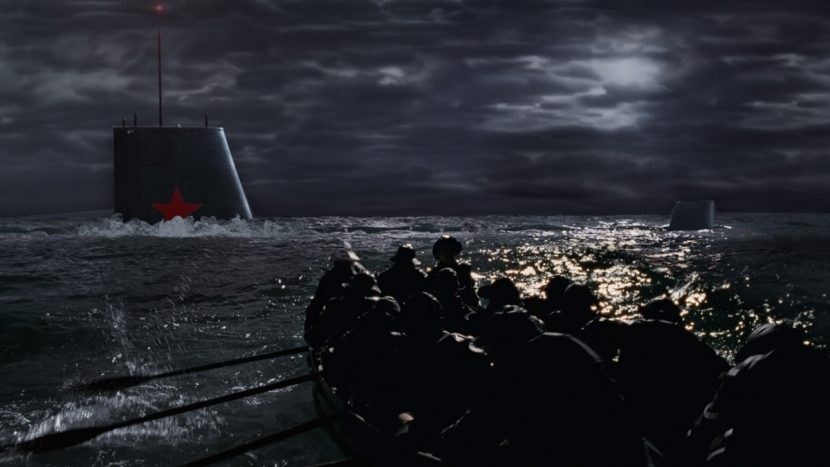
The way we looked at it going in was that we had three types of effects:
1) Present day effects – things that are in the movie which they can’t shoot, so it needed to be a visual effect.
2) Movies within the movie – those movies had visual effects and those were 50s era visual effects. For instance there’s a matte painting of Rome that’s not intending to be like Gladiator – it’s a riff off of a matte painting done by Peter Ellenshaw in 1952 (from Quo Vadis). We didn’t always use the techniques they used but we paid homage to what they did back then
3) Somewhere in-between – where the movies within the movies start to blur, such as the submarine sequence
Along the Appian Way
One of our movies within a movie is called Hail, Caesar!, a big Roman epic. This scene of the soldiers marching was shot out in Simi Valley. There’s a big Roman arch and production designer Jess Gonchor and his team built part of the bottom of the arch and then extended it with green – the reason for extending it with green was so that we got real shadows casting on the soldiers as they walked through the arch, which was something the DOP Roger Deakins wanted.
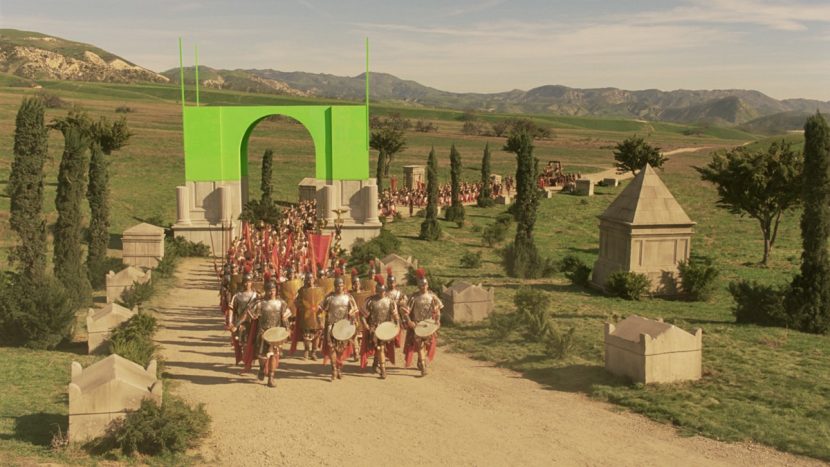
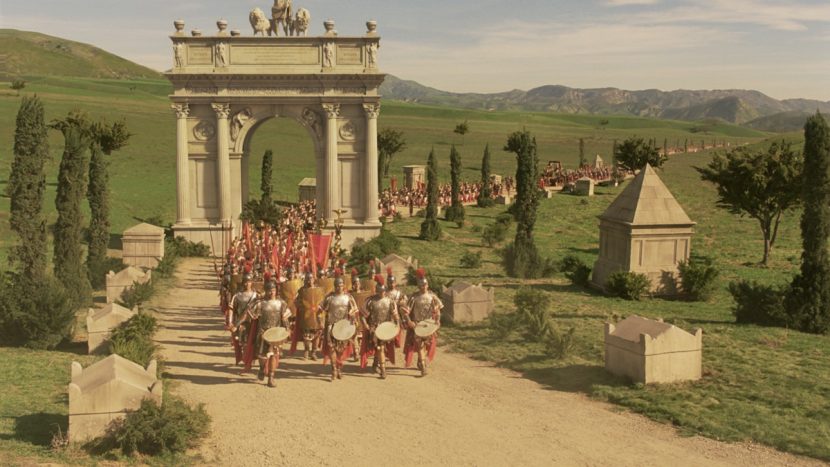
We extended the top of the arch by replacing the green with a CG arch, then tiled soldiers into the distance to give the impression of the cast of thousands. We were always thinking, what would they have done in the 50s? This was a case where back then they couldn’t do what we could do, so they would have built the entire arch and got a thousand people! For what we were doing it made sense to streamline the process by tiling the soldiers and extending them back. Some additional clean-up was done in the background as well to make it feel a little more Roman and little less like the Californian desert that it was.
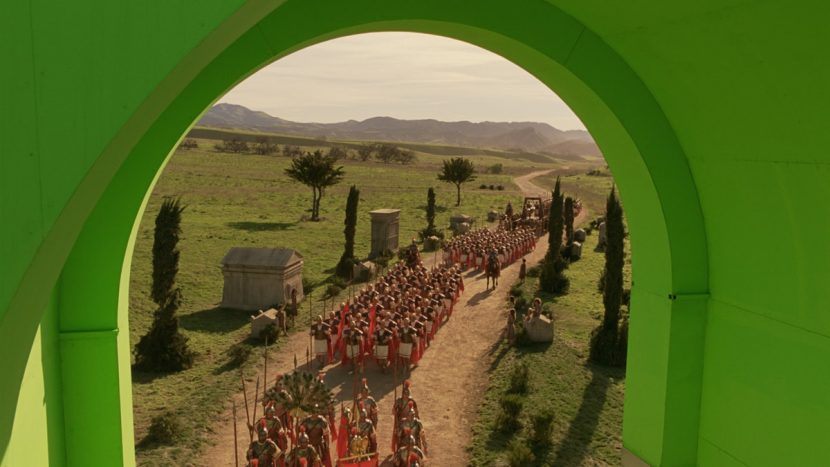
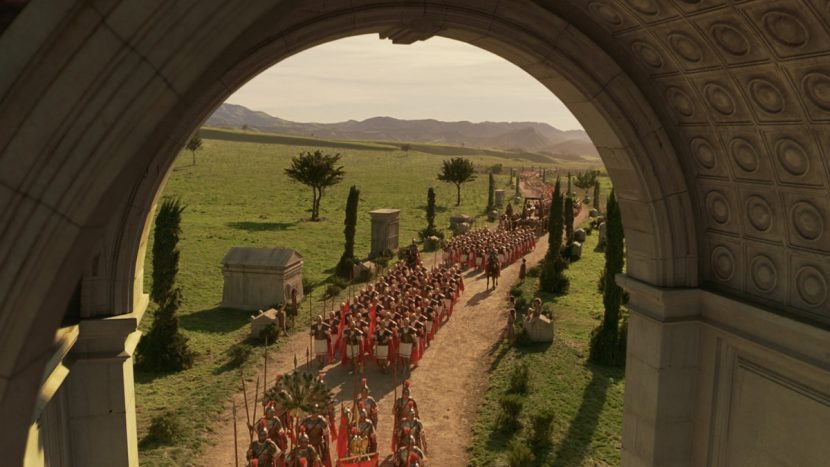
Then you realize you’re seeing this movie full-screen and you pull back on it and you see that this Hail, Caesar! film is being projected in a screening room. We created a digital matte painting of the screening room with curtains and everything, and then burned our footage into it. It’s basically a straight monitor comp with a background, but in this case we played around with the look of the projected film, as far as adding some flicker and some dirt. We left it pretty clean and gave it to Roger as shot so he had complete control in the DI and was able to dial in that flicker and the color of old film.
On the lot
One of our main environments is Capitol Studios, where Eddie Mannix (Josh Brolin). We did high wide full CG environments with a little additional matte painting of the studio lot. All this was shot on the Warner Bros. lot, which is the purest of the old movie studios and still kind of looks the way it did back then. We also filmed a lot of reference and then re-built in CG some hero stages and then created this fully CG environment for a massively high wide shot where you see the studio below. We gave it some CG people and cars to give it some life so it wasn’t completely static.
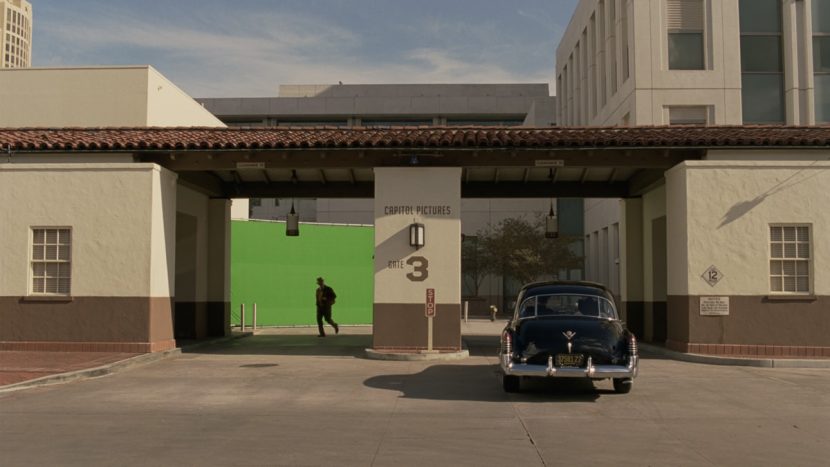
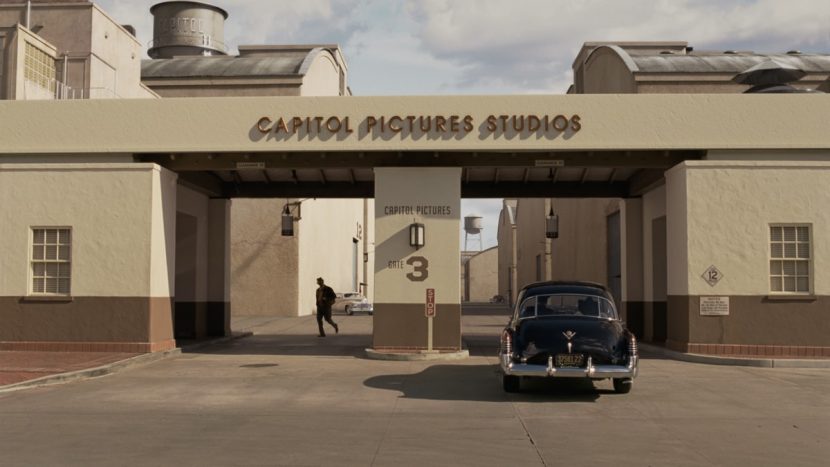
We then took those same assets – the stages and buildings – and pretty much used that throughout the shots in different scenes anytime we’re at the studio. There might be four stages along an avenue of the studio grid and we’d make it say 10 stages. There’s a couple of times where there’s a driving gate and that was shot separately, not at Warner Bros. but at Union Station in LA. We’d add the same buildings and a water tower.
There’s also a couple of walk and talk shots where Eddie and his secretary Natalie (Heather Goldenhersh) are walking through the studio, chatting rapid-fire and we’re in front of them. There’s great set dressing and cars and costumes, but the ground is covered in modern-day parking spaces and markings. So there was a huge amount of clean-up on these shots for the ground to make it look like the 1950s.
Classic Western
In one of movies within a movie, there’s the singing Western star Hobie Doyle (Alden Ehrenreich). Hobie is riding along and the bad guy comes up behind him and there’s a little bit of gunfire and added CG smoke because you can’t fire off blanks with smoke near a horse. Then Hobie is riding along, he pulls himself into a hand-stand on the horse, rides up to a tree, hooks his legs on the tree and spins around, and as he spins around he shoots the bad guy off his horse, then sits on the branch, the bad guy’s horse runs underneath and he drops onto the horse and they yell cut and that’s the end of the scene.
For that shot there was a bunch of stunt work and rigging where he was on wires and cables in order to get him to swing around properly. The other thing was that the horse won’t run under the branch. So Jess Gonchor built a tree that had a removable branch. Whenever the horse was running underneath it they would pull the branch off. The stunt player couldn’t actually hook his knees on branch at that speed – it’s not safe – so he would do it with no branch there and we would cut out at just the right moment and throw a CG branch in there so he made contact with it. So when it goes back to Hobie spinning he’s actually spinning on the branch they dressed back in.
Jonah’s Daughter
This is another movie-within-a-movie and is our big homage to Esther Williams and Busby Berkeley aquatic movies. Production found a team called the Aqualillies – an actual synchronized swimming team that still performs today in exhibitions and commercials. So we had a team of real swimmers who we used in that sequence. In the sequence we start underwater and the swimmers dive in and cross through frame and then as they cross through it reveals Scarlett Johansson as DeeAnna Moran, who swims up towards camera in a mermaid costume to a big chest filled with gold. She looks at it and all of a sudden a shadow comes over her and a giant whale mouth comes from behind camera and closes over her and goes completely black. For that one we had multiple passes underwater of the swimmers first, then a second pass with Scarlett who was on cables and we did the wire removals. Then when she got to the front we created a CG whale mouth that came in over her and engulfed her.
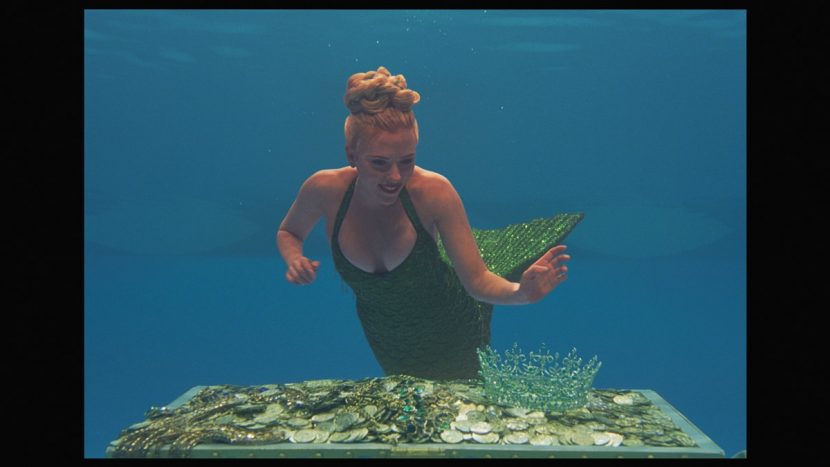
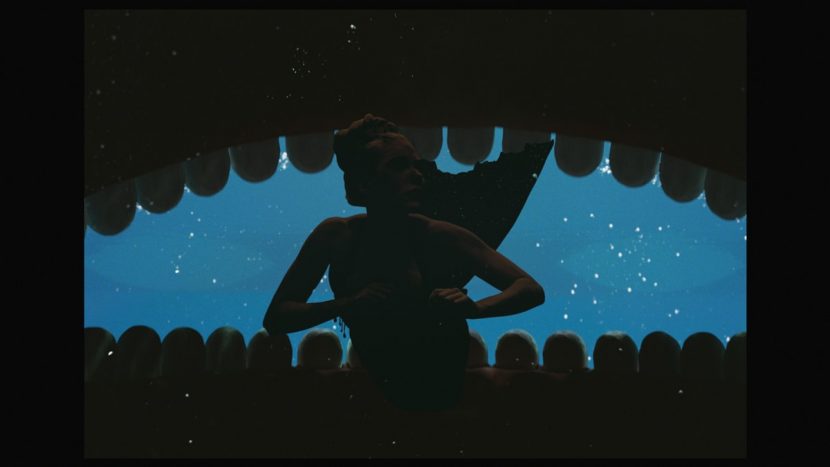
We couldn’t practically build that mouth underwater. We decided they really couldn’t have shot this so if they were going to do it they probably would have done something along the lines of an animated whale mouth like in Pinocchio – there’s an old Esther Williams movie where she swims with Tom & Jerry. Ultimately we went with more of a set-piece look in CG, but we did play around with making her edges different – we roto’d her to get the whale mouth behind her – we played around with making those a little brighter so that it looked like it was from that period. But even that just looked like a bad composite. So that line of making it look like they used to do it back then didn’t look any good to us anymore!
Then there’s this transition that brings us into a high angle shot that is straight down on the swimming pool. This was shot on a tank on the Sony lot that was shot on the same tank Esther Williams was shot on. We’re looking down on the tank and the water surface has ripples and highlights and from the depth of the pool you see the silhouette of a whale start to emerge – it comes up and breaches the surface. It fires off a spout that goes right up to camera and splashes down on the whale – the whale then descends and you see these shapes swim in from underwater and they turn out to be the Aqualillies and they go into their full synchronized swimming routine.
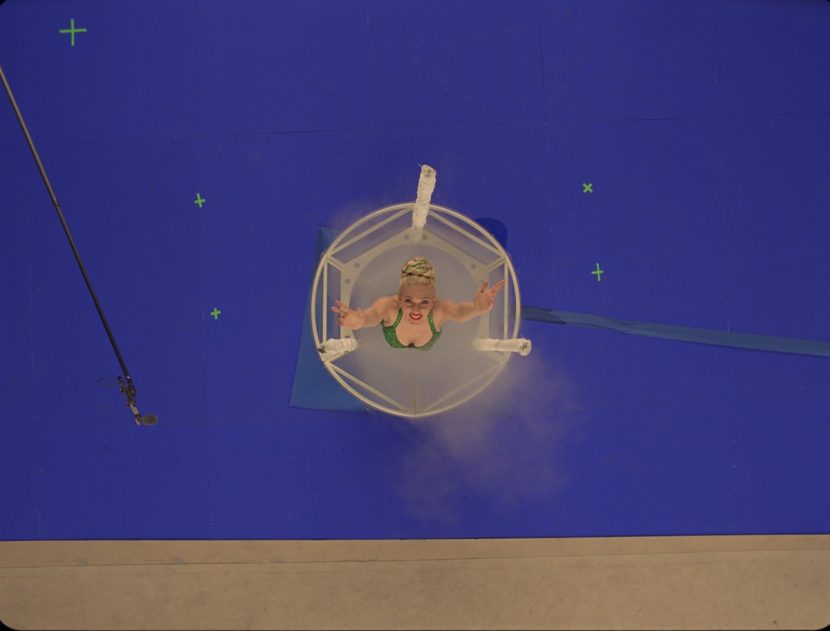
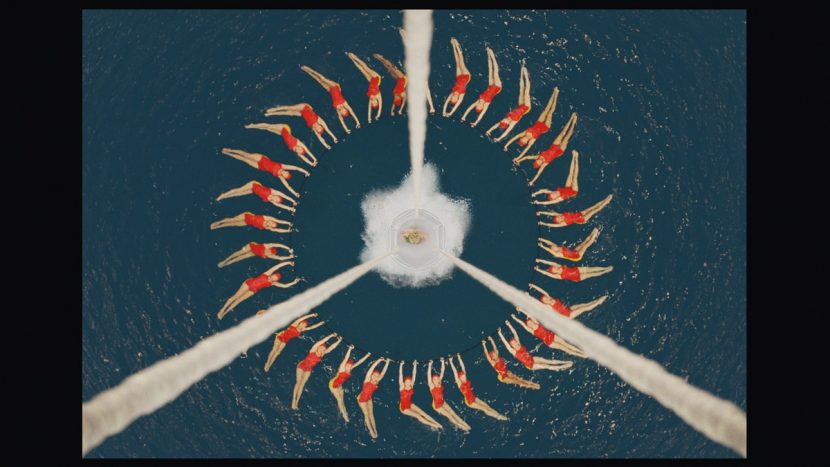
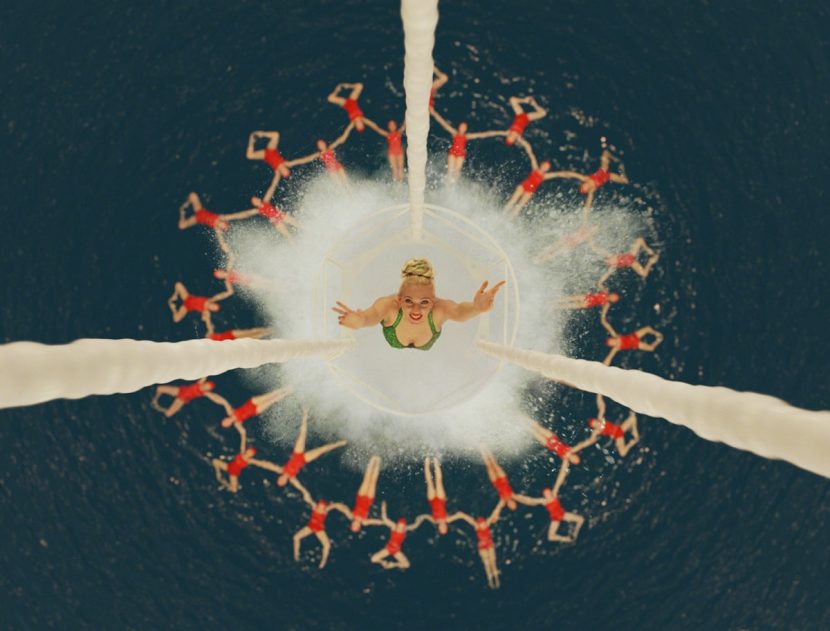
There’s another spout that comes out that hides a cut in the routine and that disappears. Then finally one more spout comes up, hits the lens and it splashes around and reveals Scarlett in a glass tulip and water around her and she’s rising up towards camera. This whole thing from when we start underwater with her and the mermaid tail all the way through to her looking down – was a single two and a half minute long shot. It was a full CG whale and full water sim on the water surface. We shot some practical spouts with the SFX team and combined those with CG spouts. We couldn’t get the camera above the tulip Scarlett was riding in because of the rigging. So if we were looking from above her she was stationary against bluescreen and we would lower the camera down to her to give the impression of the camera rising up.
At one point Scarlett dives out from the tulip which was a stuntwoman with cables. We painted out the cables and she also couldn’t really do the dive with the full mermaid tail so we added a tail fin. She had a green sleeve that her legs were in but her feet were bare. She goes underwater and rises up out of the water and that was a straight riff from those Esther Williams movies where they would just run it in reverse. So we lowered her into the pool, she’s totally dry, she gets in the pool and goes underwater and we run it in reverse and she comes up out of the water and is completely dry. She takes off her crown and it hits the conductor square in the back and that was a CG crown so that it would travel 20 yards and hit the conductor spot on.
Down at Malibu
We had a few shots at this Malibu house. There were concepts done and we did some CG cliffs and matte paintings as well as integrating some plates we shot of the ocean. The house itself was a CG build and there were some plates we had of cars coming up to the house. In the water outside of this house there are two rocks that are called split rocks that become a plot point later on in the film and we’re introduced to this whole area with a close-up of these two split rocks and a wave crashing against it. We were calling it the Barton Fink shot because as they were editing the film they wanted a more violent moment of waves crashing and they just took one of their shots from Barton Fink and cut that in just for editing purposes. What it ended up being was a fully CG shot with water sims of the waves crashing against our CG split rocks.
Then we go inside the Malibu house which was built on a set with big panorama windows that look out to the Pacific Ocean with a full greenscreen environment. We talked about whether we should put glass in the windows. We decided there were going to be a lot of reflections we were going to have to clean up from lights and crew. By taking the glass out it allowed us to play with that line between real and fake because in the 50s they might have done this with rear screen projection which wouldn’t have given you reflections.
For Malibu at night we referenced some of the North by Northwest matte paintings done by Matthew Yuricich. He did the shots of the house in that film and the Mt Rushmore scenes. We shot plates of the ocean during the day for our Malibu house and ran a day for night process digitally to give it that look. We brought in a weird painted sky to give it a surreal feel.
On the Moviola
In one scene Eddie Mannix is with his editor who is working on the cut for Merrily We Dance. She has a Moviola editing machine. It was not much more than a monitor burn-in that we did but we had to make it look a little bit old, giving it some dirt and scratches, splicing tape and some jitter. This is a case where in the movie within a movie it was a couple in a back seat in a taxi cab and so we shot them greenscreen and got stock footage and comp’d it in to make it look like a rear screen projection. We could have shot a rear screen projection but you’re not going to get anything out of it that you wouldn’t have gotten this way – and it’s just much more practical to throw up a greenscreen. We ultimately didn’t track it much and made it look like a bad comp and it worked perfectly well.
Then we’re watching the Moviola and it stutters, stutters, stops and the film starts to burn. You see the film burning. For that one we explored some different options and considered doing it digitally, but realized that that look of the film burning is so specific and so cool and organic. So we found someone – just because the Internet is a wonderful tool! – who does film burning as art. His name is Sam Spreckley and lives in Scotland. We reached out to him and he was excited to work on a Coen brothers movie.
– Above: one of the Spreckley’s works.
We knew the exact frame that the Moviola stopped and so we took that frame and printed it. It took us a little while to find anywhere in the world that would print 16mm film. Sam couldn’t burn 35mm film. We printed up a whole bunch of feed of this single frame and sent it over to Sam. He burned it, shot it on 4K and sent us Quicktimes of this frame burning. He also shot some clear leader burning and we used that to composite on top of the Moviola footage we already had to create this burning film effect. I thought that was a really good combo of practical and digital effects.
Doyle’s date
Hobie Doyle gets set up on a date with one of the young stars from the studio (Veronica Osorio as Carlotta Valdez) who is a Carmen Miranda-type character. He goes to pick her up – he’s waiting outside her house listening to country and western looking at his watch and goes into his car and pulls out a lasso and starts doing a little rope trick which then builds until he’s doing this whole routine throwing the lasso over his head and he’s jumping through the loop back and forth.
Alden learned a bunch of tricks with the lasso so we started with that as practical tricks and then after one of the cuts we go to a fully digital lasso and we gave him a little piece of rope in his hand to hold and we had a special lasso consultant to show us the routines. Alden learned everything to mime it – he also did it in a way so that when he’s moving around he’s not stepping through the digital lasso at all. The lasso had to be in a certain place based on where his wrist is. We replaced that nub he was holding. We had a couple of witness cameras to help tracking his hands. We considered a simulation for the lasso and found an academic article about the physics of lassos. Then we found they were really complicated so we went back to key frame animation of how the rope and the lasso worked. We did run a sim for the smaller piece of rope between his hands.
They also go to a nice restaurant and are sitting on a table – Hobie takes a piece of spaghetti and does a bunch of rope tricks with that including roping his fingers and her hand. We had a practical piece made of rubber so any time he was looping that it was all real but any time he’s spinning it and lassoing it in his fingers it’s a CG spaghetti – all key framed animated.
Then at the end of the scene, he turns away and turns back and it turns out he has dentures because he lost his teeth in a rodeo accident. He pulls his teeth out and that was Alden speaking and saying his lines pretending he doesn’t have teeth and then did some photogrammetry of his head to get a good track. Then we did a CG replacement for the inside of his mouth, gums and tongue for a couple of lines where he’s speaking so it played without teeth.
Sub at sea
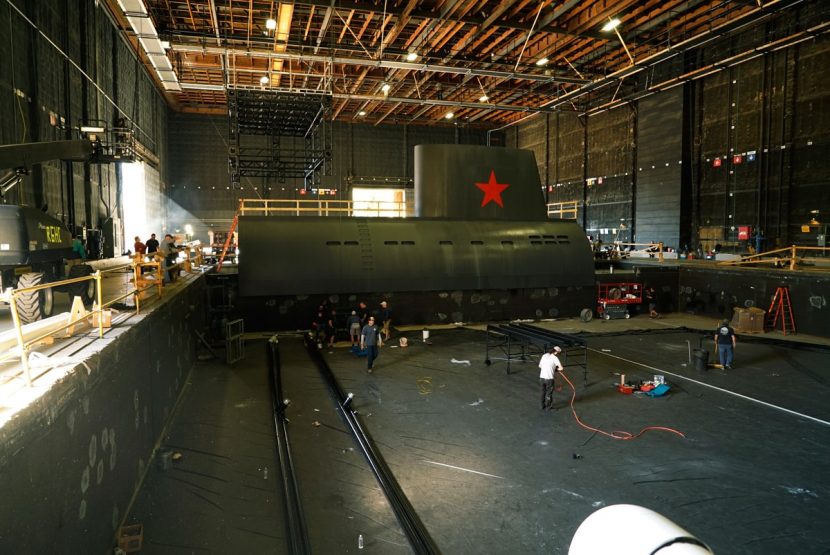
We have this big submarine sequence. One of the main references for us was the naval battle in Ben Hur where it was done in a tank with limited amount of distance, a painted backdrop and miniature boats and little explosions. Working with Roger Deakins and Jess Gonchor, we shot a lot of this in a tank with a part-sub set and a long boat that Burt Gurney (Channing Tatum) is on. Again, looking back to the 50s we thought, what they would have done is shot a miniature. We did a lot of research looking at miniature subs from that era all the way up to Das Boot which we thought was some of the best work with miniature subs until things went digital later on.
We talked about doing miniatures but in the end we decided to go with a fully digital solution on it – it gave us more flexibility to play with this line between real and fake so having the ability to finesse things a little further into the process with a digital solution worked for us. But we did it with an eye towards miniatures. So we played with depth of field, we played with the scale of the water and the speed of things as the sub was breaching to give it that look of a miniature even though we didn’t actually use any miniatures.
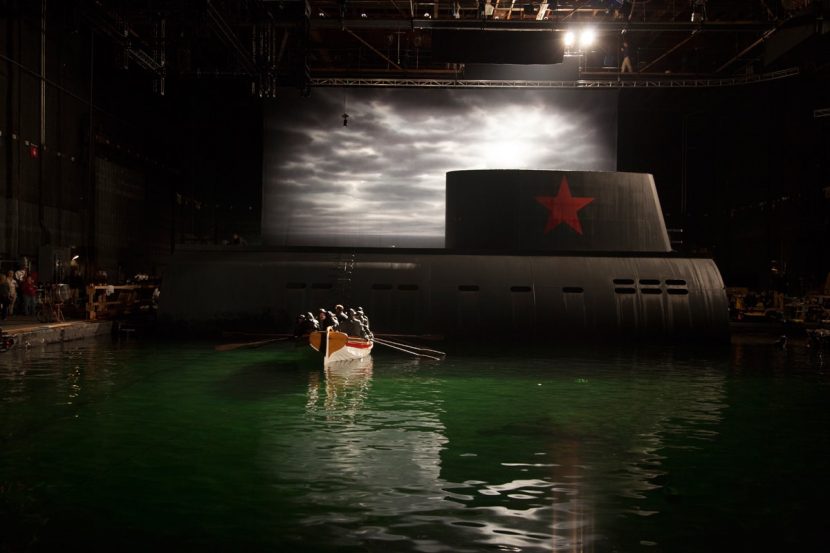
For the sub shots, there were fully CG shots with a CG sub and ocean simulations, some practical sub set with digital extensions. There’s a couple of shots where we shot in a tank and special effects co-ordinator Steve Cremin and his SFX team had some wave makers to get the right amount of chop in the water. The idea was that when the sub breaches those waves were going to be so big that there was no way that Steve could do that practically.
So there were a couple of shots where we had the long boat on a gimbal rig and shot this boat rocking on huge waves as the sub breaches. That was the actors on the boat on the gimbal with a CG sub and CG ocean behind it, including interaction of the oars. The breaching scene ends with a high wide shot of the sub in the ocean with the small long boat next to it. It was fully CG except for the long boat.
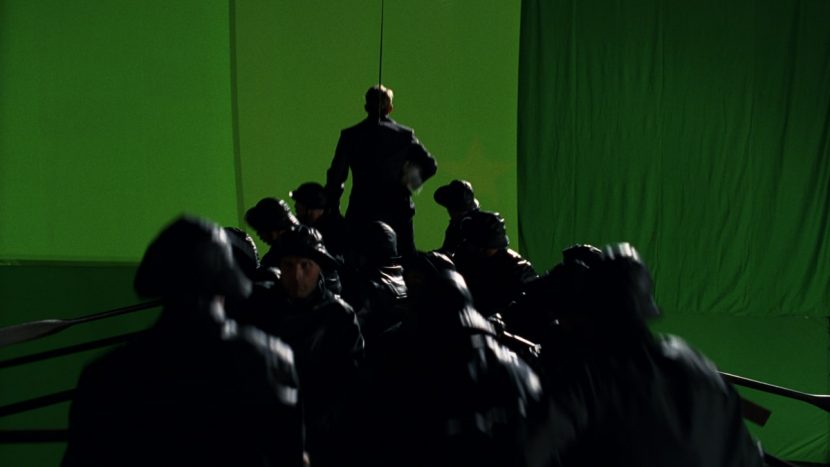
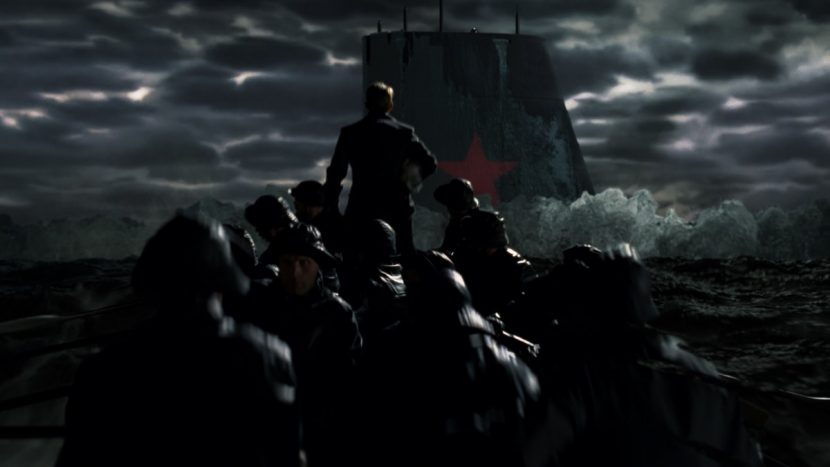
Before that, this crew take the long boat out into the middle of the ocean and in order to orient themselves to where the sub is going to breach from, they look back at the house and the two split rock is the navigation tool – when the house appears in between these two rocks, that’s when they know they’re there. We had our painted backdrop but we digitally added the house, we digitally added split rock again to look like a miniature from Ben Hur. The rocks look a little weird, the scale of the water is a little bit off. That was an example of using our digital tools to re-create something that they would have done practically, because it’s more efficient and provided us more flexibility when we needed it.
There’s also a number of shots in this sequence then where we’re extending the water and fixing up the horizon because you could see the edge of the pool and the bottom of the painted backdrop. We actually had three sides to our tank. The sub, which had sky behind it but you didn’t see any horizon because the sub was blocking it. The ocean, which was just sky. Then you had looking back towards the house and shore which was a painted backdrop of mountains and sky. For that one we digitally added the house back into the matte painting.
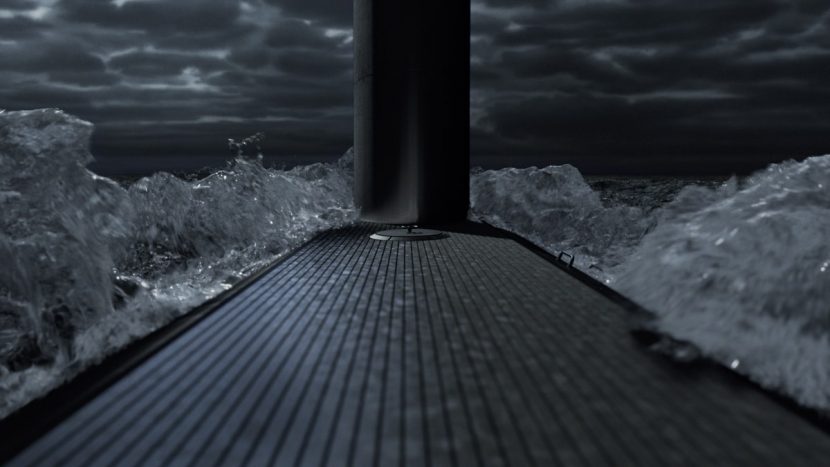
The sub then descends as the long boat scurries away, another practical combination of sub set with digital extensions, some fully digital sub shots, some with the real long boat in the foreground and some with the digital sub in the background. There’s a final shot where the camera is on the deck of the sub looking straight ahead of the conning tower and the hatch and this is just as the sub is about to descend, you see Channing get into the hatch, pull the hatch down just as the sub descends. It was a combination of the live action plate with a fully digital sub and water sims rushing over the top of the sub. Then we added CG bubbles and underwater stuff.
Back at the studio
Eventually the now rescued Baird Whitlock gets dropped off by a taxi in front of the movie studio and we did some extensions in the background. It was shot at Union Station and where he got out of the taxi is right at the cross-walk where today there is a wheelchair ramp. We had to roto him and change the length of his legs a little to make it look like he was stepping up on a curb that we added.
We go back to a high wide shot of the studio. We took some of our digital set pieces into that. The first time we see the movie studio we took the whale tail that we used in Jonah’s Daughter and you see it going into one of the stages. Then we took the sub set that we built and put that into there too. It’s really hard to tell what it is but I asked Joel and Ethan, can we do that? It’s an Easter Egg thing, no one will ever notice, and it also breaks some sort of fourth wall, because that sub is actually from the ocean, not part of the movie studio – it’s real in the movie. but the directors said yeah, sure. I mean, no one’s going to see that but I really liked that we added that in.
